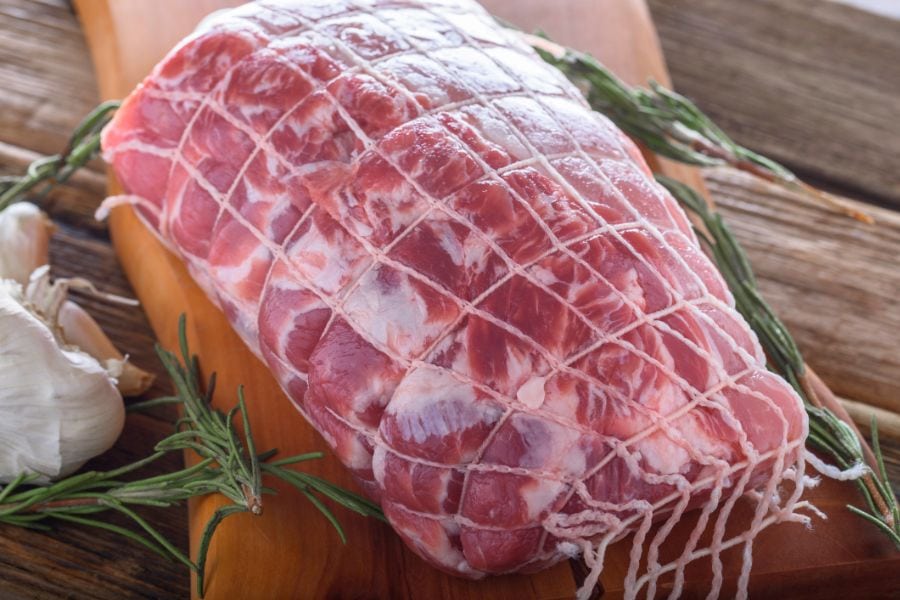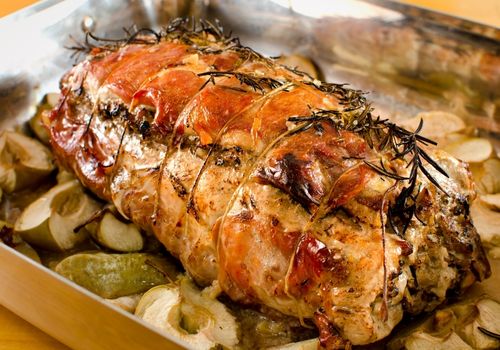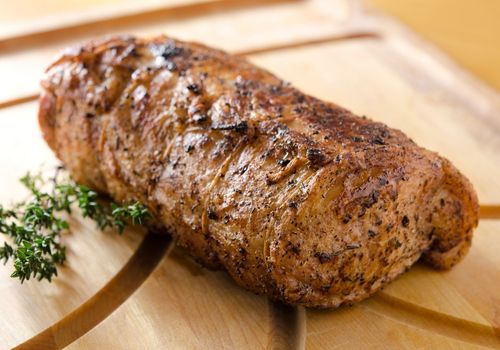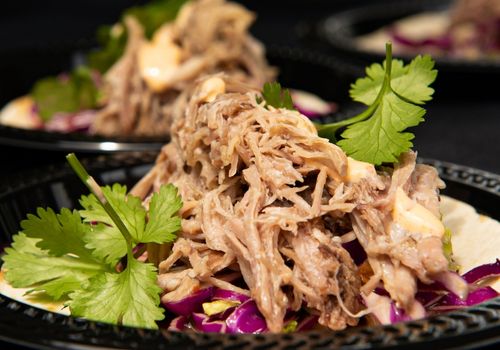The differences between pork loin and pork butt are that the loin is leaner, has less fats, more protein grams per ounce, fewer calories, and less sodium. So I always like to go for the loin for health reasons. Fans of tasty pork steaks with meaty flavor will no doubt always want to go for the pork butt.
If you are confused about these pork cuts, don’t fret. I’ll explain the differences I’ve noticed in my all years of barbecuing these delicious pork cuts.

I mentioned the differences in fats, protein, sodium, and calories earlier. Now here are the side-by-side differences in nutritional values.
Per 100-gram | Pork Loin | Pork Butt |
Calories | 192 | 292 |
Protein | 26 grams | 23 grams |
Fat | 8.8 grams | 21 grams |
Saturated Fat | 2.8 grams | 7.9 grams |
Cholesterol | 80 milligrams | 90 milligrams |
Now you see why I mentioned the loin is the healthier and the butt the tastier because of the higher fat marbling.
However, it’s worth noting that the nutritional content of pork steaks can vary depending on how it is prepared and cooked. For example, grilling and roasting tend to result in leaner cuts of pork, while frying and braising can result in cuts with higher fat content.
The nutritional content can also be affected by factors such as the breed of pig, its diet, and its living conditions. It is always a good idea to check the nutrition label on the package or consult a nutritionist for more accurate information.
Related Reading
Pork loin and pork butt, also known as pork shoulder, are both cuts of pork that come from the upper part of the pig’s body. However, they are from different parts of the pig and have some noticeable differences.
Differentiating between loin and pork in terms of appearance is easy. Pork loin is a leaner, smoother cut of meat while pork butt is interspersed by streaks of fat marbling. It’s also a more irregular cut of pork steak.
On the other hand, you’ll find that your whole pork loin is a long, slender meat cut that runs above the pig’s spine. Pork loin is a leaner cut with an even shape.
Pork butt is a thicker, bigger cut that comes from the upper part of the pig’s shoulder and the area between the pork shoulder blades. It has a more irregular shape and a rough, textured surface due to the presence of fat, muscles, and connective tissues.
Loin and pork shoulder are cooked differently. Pork loin is best cooked on high heat, while pork butt is best cooked slow on low to medium heat.
Why are these so? It’s simple.
Pork loin is a leaner cut of meat, so it can be cooked quickly using high-heat methods like, roasting, pan-frying, or grilling.
On the other hand, it is important not to overcook pork loin. It can become dry and tough if it is cooked for too long.
To make sure that the meat stays moist and tender, I advise that you use a meat thermometer to check the internal temperature of the pork loin while it is cooking.
Then also note that the USDA recommends cooking pork loin to an internal temperature of 145 degrees Fahrenheit, followed by a three-minute rest time.
Pork shoulder, on the other hand, is a fattier meat cut that tastes better when cooked under low heat.
Related Reading
In general, pork loin tends to be a bit more expensive than pork butt because it is a leaner cut of meat.
Remember in the meat world, the cheaper the meat, the fattier it is likely to be.
Pork loin is often cut into chops or roasts, which are considered to be more premium cuts of pork.
Pork butt, on the other hand, is a fattier beef cut that is generally a more affordable option than pork loin.
However, prices can vary depending on where you live and where you shop. It is always a good idea to compare prices at different stores or online to find the best deal on pork loin or pork butt.
It is also worth noting that prices can fluctuate based on supply and demand, so the price of one cut may be higher or lower than the other at any given time.

Generally, loin and pork shoulder are each different in application. Pork loin is used in dishes where it is cooked quickly on high heat, while pork butt is often used in meals that are cooked slowly under low heat.
Pork loin has less fat content, and is usually cut into roasts, chops, or tenderloins. Pork loin can be marinated, breaded, or seasoned with a variety of herbs and spices to add flavor. You may serve it as a main course, or make boneless pork chops and pork loin roast out of it.
On the other hand, pork butt has more fat. So, they taste better when you slow-cook them. You can use it for pork sandwiches.
I also enjoy cubing or slicing it to be used in dishes like stews, soups, or braises. It is often used in dishes where the connective tissues contribute to the flavor and tenderness of the final product.
Deciding which is better should depend on your usage and preference.
It is difficult to say which is better, pork loins or pork butts, as it ultimately depends on your personal taste and the specific recipe you are using. Both cuts of pork are delicious and have their unique characteristics and use in cooking.
Pork butt, also called Boston butt, and sometimes loosely referred to as pork shoulder due to the part they’re both taken from, comes from the upper part of the pig’s body.
This is a large, thick cut of pork that is packed with flavor and has a high-fat content due to the presence of fat, connective tissues, and muscle.
As I’ve explained earlier, pork butt is often used for slow-cooking techniques like braising, roasting, or smoking. As the fat and tissues break down when cooked, they add to become more tender and flavorful. You can use it to make pulled pork, where the meat is cooked slowly in a liquid, or a slow cooker until it is tender enough to be shredded.
In addition to being used in pulled pork, pork butt can also be cubed or sliced and used in dishes like stews, soups, or braises. It is a versatile meat cut that is widely used in many different types of dishes.
Pork loin (not to be confused with pork tenderloin, which is a boneless pork loin) is a long, narrow cut of pork that runs along the spine of the pig. It is a leaner cut and it has a smooth feel.
Some butchers also refer to the pork loin as the pork center rib roast.
This is a versatile cut that can be seasoned with a variety of herbs and spices to add flavor. You can serve it as a main course, either on its own or with a side dish, make some pork chops, or use it to make pork loin roast.
To make sure that the meat stays moist and tender, you should not overcook the pork loin. As recommended by the USDA, I like to cook pork loin to a minimum internal temperature of 145 degrees Fahrenheit.

So, between the pork loin and pork shoulder, which is more tender?
Well, I’d say the pork loin is generally more tender meat than pork shoulder, also known as the blade pork roast. However, you can make pork shoulder more tender when you cook them slowly.
There is a smooth surface to pork loin, which is a leaner, more tender cut of meat than pork shoulder. Pork loin is more suited for roasting, or pan-frying.
In addition to being larger and thicker, the pork shoulder can also be referred to as a pork butt. It is found at the top of a pig shoulder and has a higher fat content and connective tissue and muscle. The high muscle content makes this cut of meat tougher.
I prefer pork shoulder for making pulled pork.
When making pulled pork, you need to use a cut of pork that is well-marbled with fat, as this will help to keep the meat moist and flavorful during the cooking process. Some good options for preparing pulled pork include the pork shoulder (also known as the pork butt or Boston butt), the pork loin or pork tenderloin, and the pork belly.
The pork shoulder is a large, tough piece of meat that is perfect for braising or smoking. It has a good balance of fat and muscle, which makes it perfect for making pulled pork.
The whole pork loin is a leaner pork cut, so it may not be as tender as the pork shoulder. However, it can still be used for making pulled pork. The pork belly is another good option, as it is very fatty and will provide a lot of flavor to the finished dish.
Some like to use pork loin as an alternative meat for preparing pulled pork, but I don’t recommend this.
While it is possible to use pork loin to make pulled pork, it may not be the best choice because of its leaner nature. Pork butt has more fat and tastes delicious when braised or roasted. The connective tissues and fat in the meat break down when you cook it, resulting in a juicy, flavorful dish.
To help keep the meat moist and tender, you may want to consider adding a liquid, such as broth or cider, to the cooking pot and cooking the pork loin on low heat for a longer period. You can also add additional fat, such as bacon or lard, to help add flavor and moisture to the pork loin.
Regardless of which cut of pork you choose, it is important to cook the meat until it is tender enough to easily shred with a fork. This will typically take several hours of cooking, depending on the size of the cut and the cooking method you are using.

Pork loin is the leaner, less fatty, and low calorie cut of pork. It’s your best bet if you’re looking for a healthier cut of pork.
Pork loin is usually prepared using high-heat cooking methods for the best results. On the other hand, pork butt tastes good when cooked slowly at a low cooking temperature. It is ultimately up to you to decide which one is better for a particular recipe or meal.